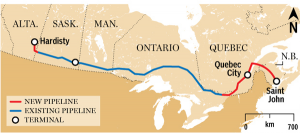Bill McKibben, NRDC and the ‘Keystoning’ of the Energy East pipeline
TransCanada and the Canadian oil industry need to significantly step up their political game with Energy East
A few months ago, uber environmentalist Bill McKibben promised that all future energy infrastructure projects will be”Keystoned.” Right on cue, McKibben’s 350.org has teamed with the NRDC to Keystone the 1.1 million b/d Energy East pipeline project. No one is surprised, but industry should be prepared.
Keystoning was coined to describe the opposition faced by the Keystone XL pipeline, the 830,000 b/d proposal by TransCanada Corp. (the same operator pitching Energy East) that was rejected by President Barack Obama in Nov. Keystoning involves celebrity opponents (think actors Robert Redford, Daryl Hannah), massive protests, civil disobedience, and social media campaigns to rally the troops.
“Every coal mine, every frack well, every oil export terminal … all of them are being met with strict, strict resistance,” McKibben told The Hill in a recent interview. “There’s people arrested every day now around the country taking on these infrastructure projects, the kind of spread of civil disobedience like we’ve never seen.”
McKibben and his merry band of climate activists have partnered with the Natural Resources Defense Council and other environmental groups to put the brakes on Energy East, which is intended to move Alberta oil sands crude to Eastern Canada, currently importing about 600,000 b/d, about half from the US and the rest from OPEC members.
The NRDC released a report Tuesday enumerating the supposed horrors that will accompany Energy East, including a “300 to 500 per cent increase in crude tanker traffic down the Atlantic coast from Saint John, New Brunswick to the U.S. Gulf Coast” that would pose a massive threat to “marine mammals like the endangered North Atlantic right whale, the Bay of Fundy’s lucrative lobster fishery, and other iconic regions like the Florida Keys.”
The threat to the ecosystem may or may not be as dire as the NRDC claims, but the report is right out of the Anti-Pipeline 101 handbook.
As McKibben suggests, this was all as predictable as the sun rising in the East every morning, though it seems to have caught some of Canada’s energy journalists completely off guard, including everyone’s favorite oil and gas shill, Claudia Cattaneo of the National Post. It shouldn’t have.
TransCanada is certainly more prepared this time than it was with Keystone XL. The company admits it was unprepared for the Keystone XL onslaught of protest and vows to do things differently with Energy East.
So, what should industry do to ward off the eco-activists and ensure Energy East is built?
First and foremost, learn from its mistakes of the past decade. There are many and it’s not clear that the c-suites of Calgary have cottoned on to the political shifts around energy. Here is the short list:
One, don’t treat First Nations as afterthoughts. This mistake – the culpability is shared equally by Enbridge and the Stephen Harper government – killed the Northern Gateway pipeline to the West Coast. Not only is there a constitutional “duty to consult,” but a slew of legal victories have given First Nations considerable clout over natural resource development.
Two, build a robust ground game. Several years ago, TransCanada rejected a PR agency’s recommendation to fund astro turf organizations that would fight environmental groups in the trenches (as the Americans do very effectively). Well, somebody has to do it, as we know all too well from the pipeline debacle in British Columbia. TransCanada and the industry associations, like the Canadian Association for Petroleum Producers, need to figure out this piece and quickly.
Three, communicate about Energy East early and often. And not just slick advertising campaigns. Modern voters, especially the younger generation, are not as influenced by television or print ads. Figure out social media and do it at least as well as the eco-activists.
Four, accept that environmental groups have the moral and legal right to oppose Energy East. Industry has to earn the right to build pipelines, rather than treat National Energy Board approval as a birthright. Stop quoting blogger Vivian Krause’s data about American charities funding Canadian opponents and acting like a victim. It ain’t the 1950s anymore, Toto.
As I described in this Canadian Business article, Prime Minister Justin Trudeau wants Energy East built and he wants it very, very badly. And Trudeau’s Liberal government will be much more active building coalitions and buying off (sorry, supporting) groups like mayors and aboriginal organizations that might pose a problem.
Industry doesn’t have to win the Energy East debate with eco-activists so much as not lose it in spectacular fashion the way it did with Northern Gateway.
If it effectively counters the Keystoning efforts of Bill McKibben, NRDC et. al., Energy East will almost certainly be built.
Are TransCanada and the Canadian oil industry up to the task? Maybe, but a hellacious fight has begun and history has not been kind to industry.











